Aside from a healthy dose of luck, a well-rounded education on aquatic insects is the most valuable piece of tackle for any fly fisher. Certainly a witless angler with a $1,000 fly rod might get lucky and catch a fish or two just out of sheer persistence, but a fly fisher with an old Fenwick Fenglass from the 70s and a studied understanding of how trout eat will always put more fish in the net.
In no instance is this so acutely obvious, I think, than in dry fly fishing. One more than one occasion, I’ve futilely thrown one good drift after another to a river boiling with trout, only to have my dry fly completely ignored.
Then, I met a guy named Ryan McCullough, who happens to be the best dry fly fisherman I’ve ever shared a river with, and who schooled me on the art of identifying rise forms. Identifying rise forms, in turn, allows you to identify what fish are eating.
His secret?
Watching.
What is a rise form?
The way Ryan explains it, a rise form is the particular movements, sounds, and disturbances on the water’s surface made by a trout eating dry flies—all of which differ depending on what a trout is eating.
For me, learning to recognize these differences led to what felt like a quantum leap forward in my angling abilities. Before, I’d get frustrated and contemplate walking off the river with an hour of daylight still left during a big hatch. Now, I’m confident that I’m fishing the right fly at the right time which means that if I’m not hooking up, it’s likely my presentation that’s to blame.
While presentation is a crucially important part of successful dry fly fishing, I don’t want to focus on that here. Instead, I want to focus on the streamside education Ryan gave me all those years ago, on a forgotten stream in the high desert of Oregon.
Emerger Eats
The first signs of a good hatch are the subtle, soft rises of trout looking up and snacking on emerging insects. Most often, this is characterized by trout rising with their dorsal fin and tails out of the water, but the rest of their body submerged. It’s as if the fish just levitates straight up in the water column, then back down again.
When trout are snacking on emergers, they don’t make the classic plop sound most often associated with rising fish. In fact, emerger rises are fairly quiet, and unless you’re paying close attention, can be hard to miss, especially in bigger water.
When you see this, it means that trout are eating bugs stuck in the surface film — or just below it. Emerging insects, especially mayflies, spend a relatively long time in the surface film as they emerge from their shucks and take flight as full duns.
Duns and Cripples
In the midst of a big hatch, you’ll see the classic rise that all anglers, I think, long for in some way — the mouth and head of a trout breaking the surface. This shows you that the trout is not only feeding with abandon, but also that it’s eating flies right off the surface.
In most cases, this sort of rise means that fish are taking either duns or cripples. I don’t want to get too far into the weeds of whether fish eat more duns or cripples (the answer is cripples), so it’s enough to remember that the rise form for trout feeding on either bug is usually the same.
You likely won’t see much more of the trout breaking the water’s surface when they’re eating duns and cripples. Trout like to position themselves right below the surface, moving up and down with their mouths open to vacuum up whatever is floating by on top. At first glance, it might look like the trout are just feeding without any regard for what they’re eating. If you take a few minutes to watch, though, you’ll see the fish targeting specific bugs — especially when they’re keyed in on duns.
Spinners and Spent-Wings
Towards the end of a hatch, mayflies in the final stage of their lives “spin” slowly back to the water’s surface to mate and lay eggs, where they’re often quickly gobbled. These bugs are, I believe, the most sought after by trout, because both spinners and spent wings are easy prey and often descend to the water in massive numbers, triggering a trout feeding frenzy.
I’m going to borrow Ryan’s words here in describing what trout look like when rising to these bugs:
“The classic head-to-tail rise is accompanied by the trout leading with an open mouth above the surface. You will know it because it will sound like constant gulping or lip-smacking. Sometimes, a trout will feed so actively that the top of his body hardly leaves the surface and you will see a half-open and closing mouth that looks more like a person swimming and breathing than a fish eating.”
Trout expend the energy to stay near the surface and eat these bugs because the payoff is worth it. During a spinner fall, the calories a trout can intake can greatly exceed what it expends by swimming against the current at the surface (which is significantly stronger than the current elsewhere in the water column).
Other Rises
There are two other rise forms that deserve mentioning here, the first being the splashy, loud rise that makes every angler whip his or her head around looking for its source when it’s heard on the river. The majority of the time, this rise is caused by a small fish trying to get to bugs before larger fish.
However, in the case of a good stonefly hatch, or if there are any terrestrials on the water, big fish will often hit those bugs hard. That behavior can cause the same splashy sounds you hear when smaller fish are eating.
And last, but certainly not least — don’t discount the smallest, most subtle rise of them all. You see this most often when fishing slow-moving water, or in crystal-clear spring creeks. It looks more like a dimple in the water’s surface than a true rise. Ryan calls these “sipping rises,” because in many cases, trout are doing just that — sipping bugs right off the water’s surface.
These are the most difficult rises to cast to, because fish that have the time to leisurely swim around, inspect flies, then casually sip them off the surface are generally well-attuned to the traps we lay for them. As someone once said to me while fishing the Green River in Utah, “It’s like the fish have time to come up and count the tailfeathers on your fly, and if there’s too many, they won’t eat.”
In these instances, a smaller bug on a light, long leader is your best friend. I love throwing small midge patterns (size 26 parachute midges are fantastic for fish like this) but if there’s a significant bug hatch on the water, try to match that as best you can.
Watch and Learn
To wrap up, I want to reinforce what I believe is the most valuable lesson I’ve ever learned in regards to fly fishing: There’s nothing wrong with sitting on the riverbank, watching trout eat, and absorbing that knowledge. You don’t have to immediately start casting when you see rising fish. In fact, I’d wager that the rush to cast and catch (or at least try to) is what leads to many anglers to leave a river of rising fish empty-handed and frustrated.
Back in March, before the world went to hell in a handbasket, I sat on the banks of a river with Ryan and we just watched. We were there to fish a blue-winged olive hatch, and the fish weren’t really working the surface. It wasn’t until we saw consistent rises on emergers that we got off the bank and started casting. All told, we spent the better part of an hour just watching those fish.
If you want to truly decode rise forms, and learn to fish the flies that trout are eating, then there’s no better teacher than the trout themselves. Take five, ten or even twenty minutes, watch feeding trout feed, and you’ll be amazed at how much you learn.




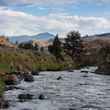
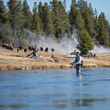
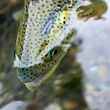



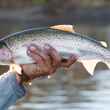



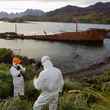
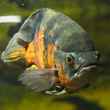




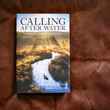



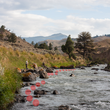
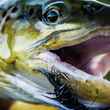



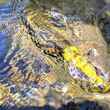
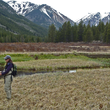
Comments